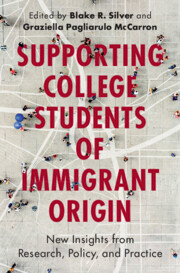Book contents
- Supporting College Students of Immigrant Origin
- Supporting College Students of Immigrant Origin
- Copyright page
- Dedication
- Contents
- Figures
- Tables
- Contributors
- Foreword
- Part I Beginnings
- Chapter 1 Understanding College Students of Immigrant Origin
- Chapter 2 The College Enrollment Process for Students of Immigrant Origin
- Chapter 3 Multilingual Adolescent Mentors and Tailored College Knowledge for Immigrant Students
- Chapter 4 The Role of Family Histories in Students of Immigrant Origin’s Aspirations and College Decision-making Process
- Chapter 5 Complicating College Readiness for Students of Immigrant Origin
- Part II Experiences
- Part III Institutional Arrangements
- Part IV Looking Forward
- Epilogue
- Index
- References
Chapter 5 - Complicating College Readiness for Students of Immigrant Origin
from Part I - Beginnings
Published online by Cambridge University Press: 16 May 2024
- Supporting College Students of Immigrant Origin
- Supporting College Students of Immigrant Origin
- Copyright page
- Dedication
- Contents
- Figures
- Tables
- Contributors
- Foreword
- Part I Beginnings
- Chapter 1 Understanding College Students of Immigrant Origin
- Chapter 2 The College Enrollment Process for Students of Immigrant Origin
- Chapter 3 Multilingual Adolescent Mentors and Tailored College Knowledge for Immigrant Students
- Chapter 4 The Role of Family Histories in Students of Immigrant Origin’s Aspirations and College Decision-making Process
- Chapter 5 Complicating College Readiness for Students of Immigrant Origin
- Part II Experiences
- Part III Institutional Arrangements
- Part IV Looking Forward
- Epilogue
- Index
- References
Summary
This chapter seeks to investigate the impact of culturally competent mentoring on college readiness for students of immigrant origin through qualitative data. Drawing from fifty-four interviews with undergraduate students at a 4-year, Minority Serving Institution, this chapter investigates how varied mentoring experiences with college preparation, at both institutional and individual levels, impact the transition into college for students of immigrant origin. We find that students identify positive experiences with both individual and institutional culturally competent mentoring. This support provides the tools to navigate from high school to college. Additionally, interview participants identify specific behaviors and practices of their mentors that align with culturally competent pedagogy. However, students who navigate through high school with culturally competent support do not necessarily find those same conditions translate to their experiences at a four-year institution. Therefore, we argue that culturally competent individual mentorship and institutional/programmatic support are critical for preparing students to enter college as well as during their higher education journeys.
- Type
- Chapter
- Information
- Supporting College Students of Immigrant OriginNew Insights from Research, Policy, and Practice, pp. 87 - 108Publisher: Cambridge University PressPrint publication year: 2024

